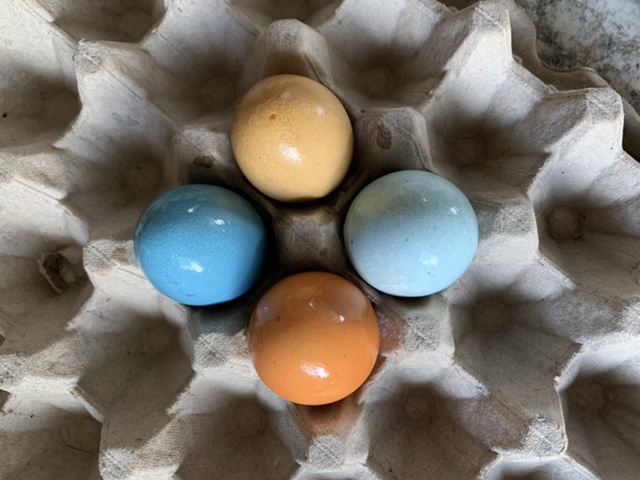This is our first year dying Easter eggs with our son. He was too little to even care about it last year, but now that he’s
three and more excited about…well everything… we of course had to dye some easter eggs! Being a natural mama, I had to go the route of making my own dyes from vegetables and food scraps. Here’s how we naturally dyed easter eggs!
First, we decided on colors. I didn’t plan to make a ton of eggs and a ton of colors, so we stuck to what we had.
It ended up being three. I had a red cabbage, to make blue, coffee grounds, for brown, and a few yellow onion skins to
make orange.


WHAT YOU’LL NEED TO NATURALLY DYE EASTER EGGS
-Eggs
-vegetables or fruits for dying
-white vinegar
-bowls and strainer
-baking soda (optional)
First, we hard boiled some eggs. We only did 11, which turned into 10 because my toddler wanted to snack on one.
Next, boil the water for whatever food you’re using. Boil for about 20-30. The longer it steeps, the stronger the color.
Then, strain the food into a bowl large enough to immerse the eggs into.

Eco tip- what to do with your food scraps? If its vegetables, throw them into a stock. Fruits, puree them and bake into fruit strips. Coffee grounds, fertilize your plants! If it’s something else, or you just don’t want to do those, the compost pile will do the work for you!
I let the dyes cool off for about 30 minutes. While they cooled down, I did the same with the eggs and had them in some cold water in the fridge.
Getting different shades of naturally dyed easter eggs
The shade depends on time soaked as well as amount of vinegar added. So for pastel colors, an hour would be good, darker shades could use an over night soaking.
Add about one and a half tablespoons of vinegar into each mixture. If you’ve got a large amount, like 10 cups, I’d double
that. If less, I’d go a half of a table spoon or just one table spoon.

I ended up splitting the purple dye (red cabbage) into two bowl because I read that if you put baking soda in the mixture
it will turn it more blue. Have your child do this because it was SUPER COOL!
Afterward, have them put the eggs into whatever colors they choose. Mine chose mostly blue, so into the purple and blue dye.
Now the waiting begins! During this time I cleaned up my messy kitchen and my son helped me do dishes while the baby napped.

Here’s what they looked like after about two hours of soaking.





The longer they soak, the darker they will be!
Here is after five hours


You could certainly soak overnight and get a wide range of shades!

I did a bit of experimenting after the first soaking. I added a teaspoon or so of vinegar more to the baking soda red cabbage mixture and they definitely came out a stronger color! If you want more vibrant colors, I’d highly recommend adding another teaspoon of vinegar to your dyes!

Food ideas for different colors
I’ve seen so many different options! Here are just a few
-blueberries – purple
-black beans – gray
-turmeric- yellow
-spinach- green
How are you dying eggs this year? Have you tried any of these colors out?

